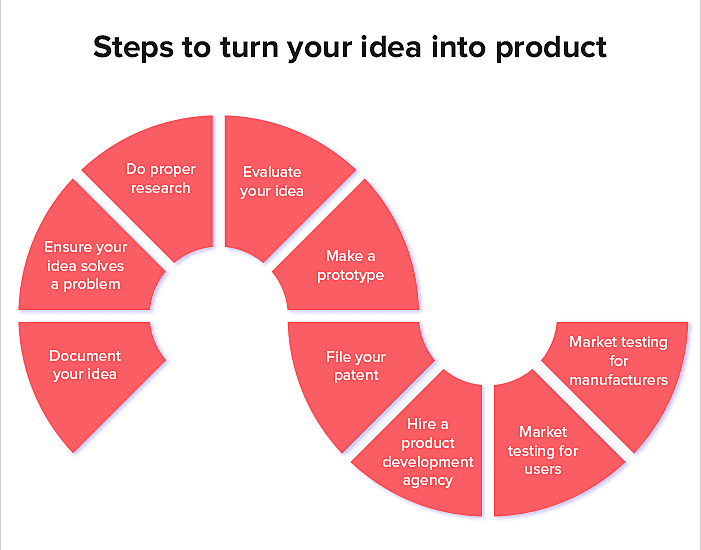
An idea can take a long time, a lot of work, and money to develop into a finished product. Following the right procedures right from the inception of a new idea to the creation of a marketable product can significantly increase your chances of success.
After knowing the right steps and action plan, no one can stop you from making your product successful, which will eventually help you grow your business. If you are curious about how to turn an idea into a product and eventually market the actual product, read this article until the end.
This article will discuss the process of turning an invention idea to product. We will start by talking about what a product idea is and the elements of a good product idea. Further, we will discuss the steps for turning an invention idea into a product. Then we will discuss tips for creating a pitch for a product idea. And lastly, we will be talking about the marketing aspect of your new product. Let's begin!
What is a product idea?
A notion or proposal for a good or service that offers consumers or businesses convenience or solves a problem qualifies as a product idea. One can make two different kinds of products:
- Consumer products: Consumer products are services or goods marketed specifically to consumers. Software for computers and food items are two examples of consumer goods
- Industrial products: Industrial products are services or goods that businesses utilize to effectively run their operations or generate new products. Raw materials and industrial equipment are two examples of industrial products
What are the elements of a good product idea?
It might be challenging to determine whether an invention or new product idea is worthwhile. For that purpose, we have provided you with the following characteristics that define a strong product idea. Make sure your product idea has the following characteristics -
- It provides a solution. The best products offer both consumer and commercial solutions.
- The product will be straightforward to use. A successful product must be simple to use so that customers can utilize it in the best case without researching or needing specialized skills.
- The costs of production and delivery are manageable. It's a good indication that you have a successful product concept if your product idea uses cheap resources to make and ship.
- A well-thought-out marketing strategy. Whether you have a formal marketing strategy in place or not, the likelihood that you have a winning product idea is high if you can imagine the tactics you would employ to advertise the product to consumers.
- The product's functionality is simple to describe. Even though certain technological solutions to problems are difficult to describe, it's a strong sign that you have a solid product idea if you can describe how the product might influence common consumers.
- The product should be easily scalable. In addition to being inexpensive to produce, a smart product idea is simple to scale up to larger facilities and administrative procedures.
- The product encourages recurring use. The fact that a product's worth rises the more a consumer uses it is another factor you should keep in mind. A streaming service, for instance, may be more beneficial to users if it offers recommendations based on user behavior.
Steps for turning an invention idea into a product

After you have a product idea that overall satisfies the above characteristics, you should be willing to use the following steps to turn your invention idea into a product -
1. Document your product idea
Having a great idea and the drive to make it happen might be exciting, but don't forget to write down your intentions in an orderly manner. Make a list of everything about the idea, including its history, sources of inspiration, the product's appearance, your expected design strategy, a list of features or functions it should have, the materials, colors, and textures it will be made of, your target market, marketing plan, the estimated manufacturing costs, the retail price, etc. Consider it a record of your brainstorming session; as you go along, the plans may change.
Ensure your notes are correctly labeled and cannot be withdrawn or reinserted without causing obvious damage wherever you keep them. You have to make an effort to make sure there are no missing or misplaced pages. With this, you provide legitimacy to the notes. Ask a trustworthy witness to sign the logbook if at all possible. Remember to describe thoroughly how you came up with the idea and all the subsequent steps that you took that you think will be significant in the future.
2. Make sure your product idea solves a problem
How can your business idea address the issues that your target market has? Some companies flourish more quickly when they concentrate on fixing the issues of their target market. By creating accounting software that is ready to use, for instance, you can assist people in managing their accounts and finances more effectively. Or you may develop a distinct photo-editing application to assist customers in personalizing their images. Another amazing app example is an on-demand mobile app that makes consumers' lives easier. Users can benefit from using a fitness tracker app to stay fit and healthy. You can address the issues of the users in countless ways.
All you have to do is determine the issues the people are experiencing and offer the finest remedy with the help of your product. You can turn your idea into an app or into a tangible product, whatever the case.
3. Do proper research on the product
If an invention cannot be sold, it has little or no financial value. It is possible to determine whether your product will appeal to your target market using a few straightforward "informal" methods. You can consult your loved ones and ask for feedback and comments on your product concept.
Even casual conversations with store owners, customers, or mobile app developers are options. This will help you understand your product better. You can also speak with individuals or students who are informed about the market for your product and get their opinion. They could offer your idea wise advice. You can also consult product experts to get a better understanding of your product idea.
You need to understand the marketability of your idea as well as whether it is really feasible before you go on to launch a new product.
4. Evaluate your idea
After researching the product, you should assess the concept more technically. Market acceptance, demand analysis, social effect, potential market concerns, business risk, competitive criteria, commercialization strategies, and experiential elements are some of the eight areas on which you should assess your product idea.
5. Make a prototype
We have simply discussed the product concept thus far. Create a functional prototype of the product after you are confident that the idea can be implemented. A prototype primarily serves as an opportunity for you to test your product. There is always a danger that the hypotheses you recorded in your notes won't hold when they are tested in actual situations.
Before you submit a patent application for the design, it will be easier to find any design problems if you have a working prototype that you can hold and use to showcase your product. The most popular methods for prototyping are:
- Start by drawing something basic by hand. No matter how crude the sketches are, you should sketch the idea to incorporate all the fundamental information, design formula, or techniques.
- Develop a 3D model of the concept with the help of the field and industry experts.
- Create a computer-animated prototype if a 3D model is not practical.
6. File your patent
Even if you don't plan to sell your creation, getting a patent can help stop another person from stealing or replicating your concept. Although a patent application can be completed without legal counsel, it is always preferable to have one review it before submission. Unfortunately, the practice of patent law is not a particularly pleasant one.
So, don't bother yourself with questions like how to patent an idea or product. Simply hire a patent attorney.
They will handle the task because you can't just file a patent for anything. After all, there are several laws and statutes to follow. Additionally, the lawyer will ensure that your patent does not violate any already-existing ones. Your competitors may find ways to register a competing patent if your patent application is weak. Doing it correctly the first time can help you avoid future, potentially expensive legal issues.
7. Hire a product development agency
Once you have implemented all the steps mentioned above, you should begin looking for the top product development firm. Before choosing an agency, you must do some web research to choose the best firm.
Look for experts with experience who can turn your concept into a fantastic product. Before choosing a business to provide product development services, consider looking at its portfolio and reading the client evaluations and testimonials. Do not be afraid to compare estimates from a few reputable companies. When selecting the best product development business, consider all the aspects.
8. Test your product with consumers
You can move on to the next stage of new product market research. Once you have a patent for your innovative consumer product design, a basic working prototype, and a few products ready for sale, you can test it with the customers. Once the product is on the market, you no longer need to worry about someone stealing your idea. Review your notes to update your target consumer's profiles and do a market test on them.
Keep in mind that small manufacturing orders are frequently more expensive to produce. You will have to bear the cost of producing a small batch of goods and managing their distribution as part of this step.
Always remember that this is only a test, not a long-term company strategy. You can decide whether you need to continue with large-scale production using the general market response and customer feedback.
9. Market testing for manufacturers
Either work together with a manufacturer to complete the manufacturing process as a team or license the product to an existing firm. The second option is more lucrative but also puts you in the middle of the action. To get better returns, you'll need to put money into investments.
You might have to weigh the benefits and drawbacks of manufacturing consumer goods in the location that you are manufacturing. However, even while licensing frees you from a potential financial burden, you can still profit from sales, albeit at a lower rate. Simply having an idea will bring you a consistent stream of money and help you in generating leads for business if your product is a success on the market.
There are several stages between having an idea and having it come to fruition as a finished product. The method may not be the quickest or simplest, but it guarantees that you receive full credit for the idea and any financial gains that might accrue from its creation. The majority of brilliant ideas and products take years to develop. If you don't succeed the first time, keep trying and refining your plan for the next time you have the chance.
Tips for creating a pitch for a product idea

You can make a pitch that briefly summarizes your product, its advantages, and its worth when you're looking for product investors, pitching your product idea, or looking for a business partner. Here are some pointers for writing an effective product pitch to sell service business ideas or product ideas to probable investors:
- Keep it brief. A concise product pitch can guarantee that the audience is interested in your product concept.
- Describe the answer. To demonstrate the value of your product, you can explain how it resolves an issue.
- Display your assurance. Speaking confidently about your product idea can persuade people to support it.
How to make a plan to market a product?
After your product has been made, you need to market the product to make sure all your effort comes to fruition. To assist you in developing your product marketing tactics, you can build a proper marketing plan. The steps to creating a marketing plan are as follows:
1) Make a SWOT analysis of your product to better understand where it stands in the market. This involves analyzing the product's strengths, weaknesses, opportunities, and threats.
2) Specify the intended market. The target market for your product can then be defined by identifying the ideal customer and the consumer group to which they belong.
3) You should set goals for what you would like your marketing strategy to accomplish once you have identified the target market for your product. To assist you in developing workable marketing strategies, it is best to define time-based and specified targets.
4) Developing marketing tactics. You will be able to identify the marketing techniques that support audience communication and the achievement of your marketing objectives once you have identified your target market and established SMART goals.
5) Make a budget. Finally, based on the objectives of your marketing plan, develop a budget for selling the product to your target market.
Conclusion
Using these procedures, you may turn any idea into a product with little to no hassle. Remember that you still need to put in a lot of effort before you can profit seriously from your new invention ideas. From the moment you have an idea until you release your product on the market, it might take a very long time.
Most product invention marketing takes years to come to fruition. You need to be diligent and patient to get the most out of your product invention strategy. You can relax knowing that your persistence and hard work will be rewarded.

Content Writer
Sakshi Kaushik is a wordsmith extraordinaire who transforms complex technical jargon into captivating, must-read articles. Armed with a Masters in Economics, Sakshi dissects intricate topics with the precision of a seasoned expert. Her insights have graced prestigious platforms like Hackernoon, Ecowiser, and Medium, captivating readers and tech aficionados alike. With a career spanning influential companies like Teleperformance, Finex, and SparxIT Solutions, Sakshi is well-versed in navigating both the keyboard and the boardroom.
In addition to her extensive experience, Sakshi holds HubSpot certifications in Digital Advertising and Content Marketing, and has earned further credentials from UpGrad, Coursera, and Great Learning. Dedicated to sharing her expertise with mobile app developers and tech enthusiasts, Sakshi's passion shines through her writing. When she's not crafting compelling content, she enjoys diving into thrilling novels and exploring diverse worlds.













